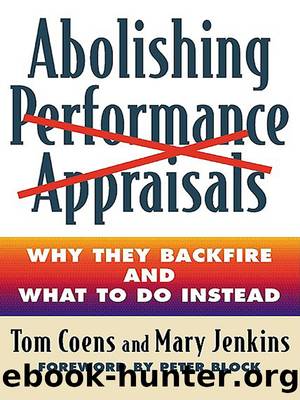Abolishing Performance Appraisals: Why They Backfire and What to Do Instead by Tom Coens & Mary Jenkins

Author:Tom Coens & Mary Jenkins
Language: eng
Format: epub
Tags: ebook, book
Publisher: Berrett-Koehler
Published: 2011-07-29T16:00:00+00:00
■ Pay Without Appraisal
Before talking about specific pay alternatives, with or without a “merit” concept, we must clarify some of the dynamics and loose terminology associated with pay practices. There is much ambiguity and misinformation about the nature of market adjustments, cost-of-living adjustments, and merit pay. Businesses love to call pay adjustments “merit pay” or “pay-for-performance” and consequently use these terms indiscriminately. The words sound so positive. People would rather be told they’re getting a merit raise or recognition pay than that they survived another year. But merit is not always merit—it means different things in different organizations.
In some organizations merit is just as the word implies. The contribution of each individual’s performance is purportedly measured, and pay or bonuses are adjusted accordingly. Some of these organizations give widely varying differentials, and others only tweak pay within very narrow limits, but in either case, the intent is to tie pay to the specific level of an individual’s performance.
In other organizations, however, they talk about merit pay, but what they really do has little to do with individual performance levels. Merit is simply a way of saying that no one gets an automatic raise, but in fact, nearly everyone gets a raise on the same formula. Variance occurs only for a tiny fraction of people who are below an acceptable level (and likely get no increase) and a few individuals who receive larger increases for various compelling reasons (not so much a reflection of good performance, but for other pressing reasons, such as to recognize a critical skill shortage or encourage a key person to stay). 164
If this approach is not really tied to individual performance levels, then what drives the increases? It’s usually a combination of cost-of-living adjustment (COLA), an across-the-board increase (in good financial times), and market adjustment. Commonly, it is just a blur of all three. (Compensation administration uses many scientific and technical words, but in practice, there’s more “winging it” than science).
Market value sounds like a definite, precise, and objective figure, but it’s not. First, the market rate is not a number, but a range—it has a high, a low, a median, and an average rate, and different organizations target different points as a goal. Second, a person within a given job often has a different market value depending on the number of years of experience. As a way of measuring such fluctuation, professional and some managerial jobs are often paid on what’s called a maturity curve. The curve is a calculation on a graph, in which years of experience are plotted against pay, as Figure 6.2 shows. There is a curve instead of a straight diagonal line because often the first two to three years are for learning and seasoning—productivity is relatively low. Until professionals, such as engineers or attorneys, get some solid experience and can work more independently, their market value is lower. As they approach proficiency, pay rises rapidly. Once they are seasoned, the size of their increase begins to diminish. In some professions,
Download
This site does not store any files on its server. We only index and link to content provided by other sites. Please contact the content providers to delete copyright contents if any and email us, we'll remove relevant links or contents immediately.
| Consulting | Entrepreneurship |
| Franchises | Home Based |
| Marketing | New Business Enterprises |
| Nonprofit Organizations & Charities |
Pioneering Portfolio Management by David F. Swensen(6226)
Man-made Catastrophes and Risk Information Concealment by Dmitry Chernov & Didier Sornette(5921)
Zero to One by Peter Thiel(5685)
The Motivation Myth by Jeff Haden(5156)
The Miracle Morning by Hal Elrod(4637)
Elon Musk by Ashlee Vance(4028)
The Art of Persistence: Stop Quitting, Ignore Shiny Objects and Climb Your Way to Success by Michal Stawicki(3624)
Unlabel: Selling You Without Selling Out by Marc Ecko(3588)
Delivering Happiness by Tony Hsieh(3365)
Urban Outlaw by Magnus Walker(3339)
Purple Cow by Seth Godin(3140)
Mastering Bitcoin: Programming the Open Blockchain by Andreas M. Antonopoulos(2981)
The Marketing Plan Handbook: Develop Big-Picture Marketing Plans for Pennies on the Dollar by Robert W. Bly(2975)
The Power of Broke by Daymond John(2897)
The Content Trap by Bharat Anand(2860)
Applied Empathy by Michael Ventura(2839)
The Airbnb Story by Leigh Gallagher(2799)
Keep Going by Austin Kleon(2696)
Radical Candor by Kim Scott(2668)
